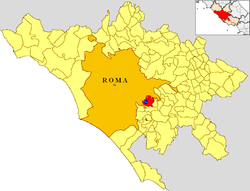Vermicino | |
|---|---|
 Northern rural area and Via di Vermicino to Selvotta | |
 Vermicino (blue spot) within the municipalities of Frascati (red), Rome (orange) and the province | |
| Coordinates: 41°49′25″N12°38′33″E / 41.82361°N 12.64250°E | |
| Country | Italy |
| Region | |
| Province | |
| Comune | |
| Elevation | 127 m (417 ft) |
| Demonym | Vermigli |
| Time zone | UTC+1 (CET) |
| • Summer (DST) | UTC+2 (CEST) |
| Postal code | 00044 |
| Dialing code | 06 |
Vermicino is a village and civil parish ( frazione ) of the Italian municipality of Frascati, in the Province of Rome, Lazio. In Italian language its name means "little worm ", in an unused form.

